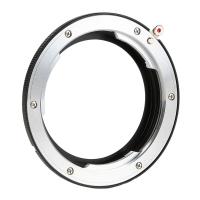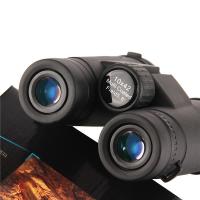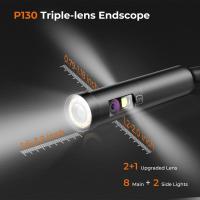How Does The Electron Microscope Work ?
An electron microscope works by using a beam of electrons instead of light to magnify objects. The electrons are focused using electromagnetic lenses and directed onto the object being studied. As the electrons interact with the object, they produce signals that are detected and used to create an image. The resulting image is much more detailed than what can be seen with a traditional light microscope, allowing scientists to study the structure and composition of materials at a much smaller scale. There are two main types of electron microscopes: transmission electron microscopes (TEM) and scanning electron microscopes (SEM). TEMs use a thin sample that is placed in the path of the electron beam, allowing the electrons to pass through and create an image of the internal structure of the sample. SEMs, on the other hand, use a focused beam of electrons to scan the surface of a sample and create a 3D image of its topography.
1、 Electron beam generation

The electron microscope is a powerful tool used to observe the structure of materials at a very high resolution. It works by using a beam of electrons instead of light to create an image of the sample being studied. The electron beam is generated by an electron gun, which uses a heated filament to release electrons. These electrons are then accelerated by an electric field and focused into a narrow beam by a series of electromagnetic lenses.
Once the electron beam is generated, it is directed towards the sample being studied. As the beam interacts with the sample, it scatters and reflects electrons, creating a pattern that is detected by a detector. This pattern is then used to create an image of the sample, which can be viewed and analyzed by the researcher.
One of the latest developments in electron microscopy is the use of aberration-corrected lenses. These lenses are able to correct for distortions in the electron beam caused by the electromagnetic fields used to focus it. This allows for even higher resolution imaging, with the ability to see individual atoms and their arrangement within a material.
Overall, the electron microscope is a powerful tool that has revolutionized our understanding of the structure and properties of materials. With continued advancements in technology, it is likely that even more detailed and precise imaging will be possible in the future.
2、 Electromagnetic lenses

The electron microscope is a powerful tool used to observe the structure of materials at a very high resolution. It works by using a beam of electrons instead of light to create an image of the sample being observed. The electrons are accelerated through a vacuum and focused onto the sample using electromagnetic lenses.
Electromagnetic lenses are used to focus the electron beam onto the sample. These lenses work by using a magnetic field to bend the path of the electrons. The strength of the magnetic field can be adjusted to control the focus of the beam. This allows for very precise control of the electron beam, which is necessary for high-resolution imaging.
The latest point of view on electron microscopy is the development of aberration-corrected electron microscopy. This technique uses advanced electron optics to correct for aberrations in the electron beam, which can limit the resolution of the microscope. Aberration correction allows for even higher resolution imaging, with the ability to resolve individual atoms in some cases.
In summary, the electron microscope works by using a beam of electrons and electromagnetic lenses to create an image of the sample being observed. The latest development in electron microscopy is aberration correction, which allows for even higher resolution imaging.
3、 Sample preparation

How does the electron microscope work?
The electron microscope works by using a beam of electrons instead of light to magnify objects. The electron beam is focused onto the sample using electromagnetic lenses, and the electrons interact with the sample to produce an image. The resolution of the electron microscope is much higher than that of a light microscope, allowing for the visualization of much smaller structures.
Sample preparation is a crucial step in electron microscopy. Samples must be thin enough for the electrons to pass through, and they must be free of contaminants that could interfere with the imaging process. There are several methods for preparing samples for electron microscopy, including cutting, grinding, and etching. In some cases, samples may be frozen and then fractured to create a thin section for imaging.
Recent advances in electron microscopy have led to the development of new techniques that allow for the visualization of biological samples in unprecedented detail. Cryo-electron microscopy, for example, involves freezing samples in liquid nitrogen and then imaging them at very low temperatures. This technique has been used to study the structure of proteins and other biomolecules, and has led to new insights into the workings of the cell.
In conclusion, the electron microscope works by using a beam of electrons to magnify objects, and sample preparation is a crucial step in the imaging process. Recent advances in electron microscopy have led to the development of new techniques that allow for the visualization of biological samples in unprecedented detail.
4、 Imaging modes

How does the electron microscope work?
The electron microscope is a powerful tool used to study the structure and properties of materials at the atomic and molecular level. Unlike traditional light microscopes, which use visible light to illuminate samples, electron microscopes use a beam of electrons to create highly detailed images.
There are two main imaging modes used in electron microscopy: transmission electron microscopy (TEM) and scanning electron microscopy (SEM). In TEM, a beam of electrons is transmitted through a thin sample, and the resulting image is formed by the interaction of the electrons with the sample. This mode is particularly useful for studying the internal structure of materials, such as the arrangement of atoms in a crystal lattice.
In SEM, the electron beam is scanned across the surface of a sample, and the resulting image is formed by detecting the electrons that are scattered or emitted from the sample. This mode is useful for studying the surface morphology of materials, such as the shape and size of particles or the texture of a material.
Recent advances in electron microscopy have allowed for even higher resolution imaging, such as aberration-corrected TEM and helium ion microscopy. These techniques have enabled researchers to study materials with unprecedented detail, revealing new insights into the properties and behavior of materials at the nanoscale.






























There are no comments for this blog.